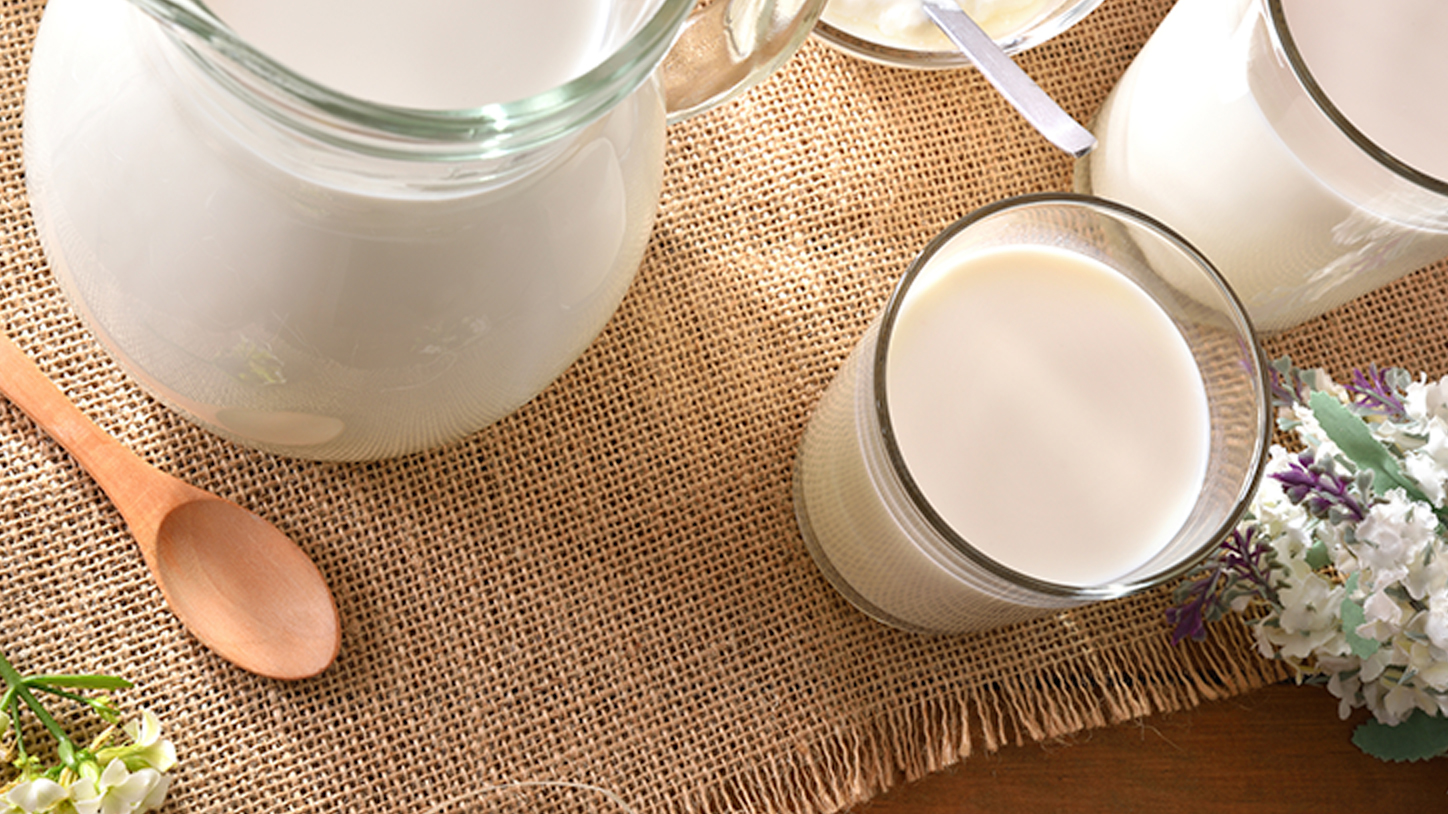1) What is lactose anyway?
It is the main sugar found in milk, present in a proportion of 5%. In addition to providing energy, it plays an important role in the intestines where it transforms into lactic acid, a natural antiseptic. Lactose is composed of two simple sugars: glucose and galactose. It must be split in two by an intestinal enzyme called lactase in order to be digested.
2) Is it true that most humans cannot digest milk?
It is true that the production of intestinal lactase decreases significantly after weaning. At age one, the level of lactase activity in a baby represents only half of what it was at birth. Between ages three to five, lactase decreases between 90 to 95% in three-quarters of the world's population. Many people, including those who are black, Asian, Native American or Spanish, are considered to have a reduced ability to digest the lactose in milk. It is a normal phenomenon in human physiology. This condition is less present in the northern populations of Europe and America, as well as in some nomadic groups, such as the Bedouins in the Middle East and Tuaregs or 'Blue People' of the Sahara.
Nature being what it is, the body adapts and manages to tolerate a certain amount of lactose at a time. However, when lactose consumption exceeds the ability to digest it, gastrointestinal conditions appear (cramps, bloating, flatulence, diarrhea) 30 minutes to two hours after consuming the milk or dairy product. The effect varies from one person to the next. This discomfort is caused by bacterial fermentation of sugars that are not completely absorbed by the small intestine, leading to gas production in the colon.
3) What to do if you suspect a milk intolerance?
Share any concerns you may have with your doctor. He or she will conduct a hydrogen breath test or blood sugar test. "I haven't ordered one of these tests in more than 20 years," states Dr. Patrick Godet, gastroenterologist at LaSalle Hospital. "Lactose-intolerant people don't really need to take these tests, because they have already made the connection between their condition and milk consumption. The symptoms disappear completely after removing dairy products from their diet for several days."
However, the doctor will monitor to ensure there is no other underlying issue.
In fact, many people - with no absorption problems whatsoever - eliminate milk from their diet after experiencing diarrhea or indigestion. According to Dr. Godet, their problem could have been caused by: 1) another food (e.g. cabbage or onion family, legumes, hot spices); 2) a digestive condition such as celiac disease or Chron's disease; 3) food poisoning; 4) or occurred after taking antibiotics or be due to a travelling illness such as Montezuma's revenge. In these cases, lactose intolerance is only temporary and most people gradually recover. Others maintain the intolerance for a longer period of time.
4) So why insist on milk?
Eliminating all traces of milk from your diet is not without consequence. Milk is an economical food, extremely versatile in cooking (soup, sauce, pancakes, pudding, desserts...) and has a high nutritive value. It, alone, provides 16 essential nutrients, including high-quality protein, lots of assimilable calcium and vitamin D.
In 2010, the National Institutes of Health, the highest authority on American health, stated in its scientific consensus that people with lactose intolerance (real or perceived) who avoid dairy products ingest an inadequate amount of calcium and vitamin D, two nutrients essential to bone health. An interesting fact: people with lactose intolerance who consume dairy products exhibit fewer symptoms than those who consume none. Before banning milk and dairy products from your diet forever, read the answer to the next question.
5) Should you eliminate all dairy products from your diet?
No, it depends on your individual tolerance. Contrary to popular belief, most people who are lactose intolerant can consume some dairy products and exhibit few symptoms, and improve their tolerance with regular lactose consumption.
- Milk: Even with reduced enzymatic activity, many people can tolerate whole milk at meals, a little bit at a time (125 ml or 1/2 cup). Milk with 3.25% milk fat is preferable to skim milk, because the fat it contains slows down its passage through the digestive tract. If even milk in small doses is giving you a problem, choose a ready-to-drink lactose-reduced milk, such as Lactaid ® et Lacteeze ®, sold in most grocery stores. It does, however, have a sweeter taste than regular milk. There's also lactase drops on the market that you can use to treat regular milk 24 hours before drinking it. The drops work to break lactose down into digestible fragments.
- Cheese: With the exception of processed cheese and fresh cheese (cottage, ricotta, white cheese…), ripened cheese naturally contains very little lactose. According to agronomist Jacques Goulet, professor of Food Science and Nutrition at Laval University, 80 to 90% of lactose is eliminated in the form of whey during the manufacture of cheese; the rest breaks down as cheese ages. A good tip: the lower the moisture content, the less lactose a cheese contains.
- Fermented milk products: Yogurt is usually well tolerated, even in the most severe cases of lactose intolerance. Look for those with probiotics (all strains, except Lactobacillus GG), active bacterial cultures that produce enzymes needed to digest lactose. Fermented milk probiotic, such as Bio-K+, acts like yogurt to help in the digestion of lactose. Finally, kefir, a veritable consortium of more than 30 microorganism species, is another great choice, because it contains lactic acid bacteria and yeast that transforms lactose into lactic acid and alcohol (hence kefir's sparkling effect).
6) What to do at restaurants or when visiting friends?
It is a good idea to have lactase tablets on hand. You can swallow this artificial enzyme just before consuming dairy products. It is sold over-the-counter at the pharmacy.
7) Goat, sheep, soy... what about other milk?
All mammal milk, including goat and sheep, contains lactose. As for soy, it is a drink made from water and soybeans. Therefore, it is lactose free. If you do drink it, make sure to choose a soy beverage enriched with vitamin D and calcium.
8) Does cooking destroy lactose?
No, lactose does not disappear during cooking. Soup, béchamel sauce, rice pudding, crème caramel, tapioca, pancakes… all these foods are a significant source of lactose.
9) What's the difference between lactose intolerance and a milk allergy?
Food intolerance refers to gastrointestinal symptoms that appear after eating certain foods. From a medical point of view, this does not harm the physical health of the affected person. In the case of lactose, the intolerance is linked to a carbohydrate in milk. A milk allergy is caused by the immune system's abnormal reaction to milk protein. It begins in infancy, disappears around the age of three, and is rare in adults. Allergic reactions can include: hives, rash, eczema, diarrhea or constipation, nasal congestion, cough, difficulty breathing and vomiting. This is a serious problem that must be handled by a child's pediatrician or an allergist.
10) Is drinking milk unnatural?
Some argue that humans are the only species to drink another mammal's milk. They note that, after weaning, the human body stops producing the enzyme required to digest lactose, a sign that we should avoid dairy products. Other people counter by saying the colon adapts to the presence of lactose and can handle it. This is the same situation with legumes; the body does not possess the enzymes required to digest their complex carbohydrates. Yet it grows accustomed to it, little by little, and the digestive discomfort gradually disappears. Humans are also the only species to cook food, wear clothes, grow vegetables and walk on the moon. The debate continues... everyone is free to draw their own conclusions!
Food - Serving - Lactose Content (g)
- Buttermilk - 250 ml (1 cup) - 12g
- Butter - 5 ml (1 tsp.) - traces
- Cheese (blue, camembert, cheddar, cream, gruyère) - 28g (1 oz.) - traces
- Cottage - 125 ml (1/2 cup) - 2g to 4g
- Fresh cream - 15 ml (1 tbsp.) - 0.5g
- Ice cream and ice milk - 125 ml (1/2 cup) - 5g
- Milk (cow, goat) - 250 ml (1 cup) - 11g
- Parmesan cheese (grated) - 15 ml (1 tbsp.) - traces
- Yogurt - 125 ml (1/2 cup) - 6g

